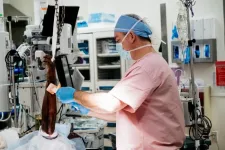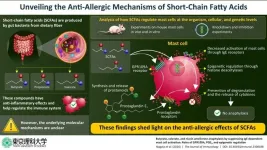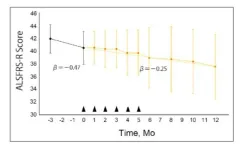(Press-News.org) University of Virginia scientists have developed a new approach to machine learning – a form of artificial intelligence – to identify drugs that help minimize harmful scarring after a heart attack or other injuries.
The new machine-learning tool has already found a promising candidate to help prevent harmful heart scarring in a way distinct from previous drugs. The UVA researchers say their cutting-edge computer model has the potential to predict and explain the effects of drugs for other diseases as well.
“Many common diseases such as heart disease, metabolic disease and cancer are complex and hard to treat,” said researcher Anders R. Nelson, PhD, a computational biologist and former student in the lab of UVA’s Jeffrey J. Saucerman, PhD. “Machine learning helps us reduce this complexity, identify the most important factors that contribute to disease and better understand how drugs can modify diseased cells.”
“On its own, machine learning helps us to identify cell signatures produced by drugs,” said Saucerman, of UVA’s Department of Biomedical Engineering, a joint program of the School of Medicine and School of Engineering. “Bridging machine learning with human learning helped us not only predict drugs against fibrosis [scarring] but also explain how they work. This knowledge is needed to design clinical trials and identify potential side effects.”
Combining Machine Learning, Human Learning
Saucerman and his team combined a computer model based on decades of human knowledge with machine learning to better understand how drugs affect cells called fibroblasts. These cells help repair the heart after injury by producing collagen and contract the wound. But they can also cause harmful scarring, called fibrosis, as part of the repair process. Saucerman and his team wanted to see if a selection of promising drugs would give doctors more ability to prevent scarring and, ultimately, improve patient outcomes.
Previous attempts to identify drugs targeting fibroblasts have focused only on selected aspects of fibroblast behavior, and how these drugs work often remains unclear. This knowledge gap has been a major challenge in developing targeted treatments for heart fibrosis. So Saucerman and his colleagues developed a new approach called “logic-based mechanistic machine learning” that not only predicts drugs but also predicts how they affect fibroblast behaviors.
They began by looking at the effect of 13 promising drugs on human fibroblasts, then used that data to train the machine learning model to predict the drugs’ effects on the cells and how they behave. The model was able to predict a new explanation of how the drug pirfenidone, already approved by the federal Food and Drug Administration for idiopathic pulmonary fibrosis, suppresses contractile fibers inside the fibroblast that stiffen the heart. The model also predicted how another type of contractile fiber could be targeted by the experimental Src inhibitor WH4023, which they experimentally validated with human cardiac fibroblasts.
Additional research is needed to verify the drugs work as intended in animal models and human patients, but the UVA researchers say their research suggests mechanistic machine learning represents a powerful tool for scientists seeking to discover biological cause-and-effect. The new findings, they say, speak to the great potential the technology holds to advance the development of new treatments – not just for heart injury but for many diseases.
“We’re looking forward to testing whether pirfenidone and WH4023 also suppress the fibroblast contraction of scars in preclinical animal models,” Saucerman said. “We hope this provides an example of how machine learning and human learning can work together to not only discover but also understand how new drugs work.”
Findings Published
The researchers have published their findings in the scientific journal PNAS, the Proceedings of the National Academy of Sciences. The research team consisted of Nelson, Steven L. Christiansen, Kristen M. Naegle and Saucerman. The scientists have no financial interests in the work.
The research was supported by the National Institutes of Health, grants HL137755, HL007284, HL160665, HL162925 and 1S10OD021723-01A1.
To keep up with the latest medical research news from UVA, subscribe to the Making of Medicine blog at http://makingofmedicine.virginia.edu.
END
Promising heart drugs ID'd by cutting-edge combo of machine learning, human learning
2024-02-01
ELSE PRESS RELEASES FROM THIS DATE:
Large multicenter clinical trial finds that antiseptic containing iodine reduces surgical-site infections in patients with extremity fractures
2024-02-01
A large multicenter clinical trial co-led by University of Maryland School of Medicine researchers large multicenter clinical trial co-led by University of Maryland School of Medicine researchers found that an antiseptic containing iodine resulted in about one-quarter fewer post-surgical infections in patients with limb fractures compared to another frequently used skin antiseptic. The results of the study of nearly 8,500 patients across the United States and Canada were published today in the New England Journal of Medicine.
The study – which compared the ...
Jealousy – we understand our own sex best
2024-02-01
We may not always fully understand why our partners get jealous, and women and men often get jealous for completely different reasons.
Two researchers from the Norwegian University of Science and Technology (NTNU) decided to investigate whether people also know about these distinct differences between the sexes.
“What do people think triggers women’s and men’s jealousy? How well do women understand men’s jealousy, and men women’s jealousy? We wanted to find out,” says Professor Mons Bendixen at the Department of Psychology.
Men are more jealous ...
Hiring the most qualified candidate might be unfair
2024-02-01
WASHINGTON — Both liberals and conservatives are more likely to believe that merit-based hiring is unfair after learning about the impacts of socioeconomic disparities, according to a study published by the American Psychological Association.
People from across the political spectrum also are more likely to support programs that encourage socioeconomic diversity after learning about the effects of social class and low income, according to the research, published online in the Journal of Experimental Psychology: General.
“Socioeconomic disadvantages early in life can undermine educational achievement, ...
Excavation of colossal caverns for Fermilab’s DUNE experiment completed
2024-02-01
Excavation workers have finished carving out the future home of the gigantic particle detectors for the international Deep Underground Neutrino Experiment. Located a mile below the surface, the three colossal caverns are at the core of a new research facility that spans an underground area about the size of eight soccer fields.
Hosted by the U.S. Department of Energy’s Fermi National Accelerator Laboratory, DUNE scientists will study the behavior of mysterious particles known as neutrinos to solve some of the biggest questions about our universe. Why is our ...
BIPOC individuals bear greater post-COVID health burdens, new research suggests
2024-02-01
Black, indigenous, and people of color (BIPOC) who were infected with COVID-19 experienced greater negative aftereffects in health and work loss than did similarly infected white participants, new research finds.
Despite similar symptom prevalence, BIPOC and Hispanic patients experienced greater negative impacts on their health status, activity levels, and ability to work compared with non-Hispanic and white patients participating in the ongoing multi-site INSPIRE clinical trial examining people with long COVID.
The findings are published in the journal Frontiers ...
National Academy of Medicine member new president of The Obesity Society
2024-02-01
ROCKVILLE, Md. — A member of the National Academy of Medicine is the new president of The Obesity Society (TOS), the organization announced today.
Jamy Ard, MD, FTOS, is professor in the Departments of Epidemiology and Prevention and Internal Medicine and vice dean of Clinical Research at Wake Forest University School of Medicine in Winston-Salem, N.C. He also co-directs the Atrium Health Wake Forest Baptist Weight Management Center, where he oversees medical weight management programs.
“I am honored to serve as president of ...
How to run a password update campaign efficiently and with minimal IT costs
2024-02-01
Updating passwords for all users of a company or institution’s internal computer systems is stressful and disruptive to both users and IT professionals. Many studies have looked at user struggles and password best practices. But very little research has been done to determine how a password update campaign can be conducted most efficiently and with minimal IT costs. Until now.
A team of computer scientists at the University of California San Diego partnered with the campus’ Information Technology Services to analyze the messaging for a campuswide mandatory ...
Five advances that could change heart health monitoring
2024-02-01
Chocolate valentines and candies with sweet sayings shouldn't be the only hearts you think about this February. It’s also American Heart Month, which puts a spotlight on cardiovascular health. According to the American Heart Association, heart disease is the leading cause of death for Americans, so it’s important to know the status of your own heart health. New methods for cardiac monitoring can be found in these five papers recently published in ACS journals. Reporters can request free access to these papers by emailing newsroom@acs.org.
Future ...
Gut bacteria can process dietary fiber into an anti-allergy weapon, finds new study
2024-02-01
The intricate relationship that exists between humans and the gut microbiome has become a hot research topic, and scientists are constantly uncovering new reasons why a healthy diet can lead to a healthier life. Dietary fibers are a particularly important aspect of this connection. When we ingest these compounds, which are mainly found in plant-based foods, our gut bacteria break them down into small molecules, called short-chain fatty acids (SCFAs). Over the past few years, studies have revealed various important anti-inflammatory and immunomodulating effects of SCFAs.
One of the ways SCFAs interact with ...
Insights from a phase II clinical trial with CL2020 Muse cell-based therapeutic for Amyotrophic lateral sclerosis
2024-02-01
Amyotrophic lateral sclerosis (ALS) is a neurodegenerative disease characterized by progressive loss of motor functions, which eventually leads to death within 5 years of its onset. This disease causes weakness and atrophy of limbs and other muscles, which affect mobility speech, eating, and even breathing in patients. Some drugs, including riluzole, edaravone, and sodium phenylbutyrate/taurursodiol are used for treating ALS, but with limited therapeutic benefits. Therefore, novel, effective ALS treatments are the need of the hour.
Multilineage-differentiating stress-enduring (Muse) cells are pluripotent stem cells ...




